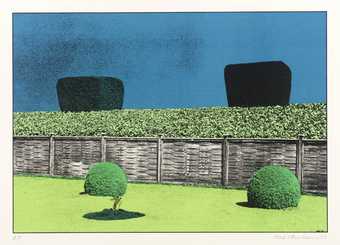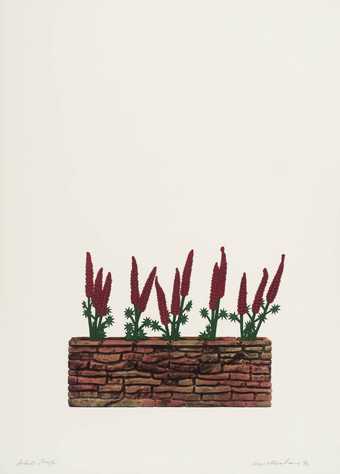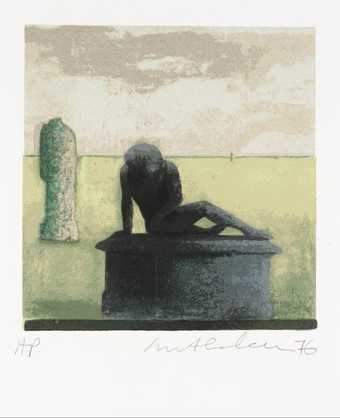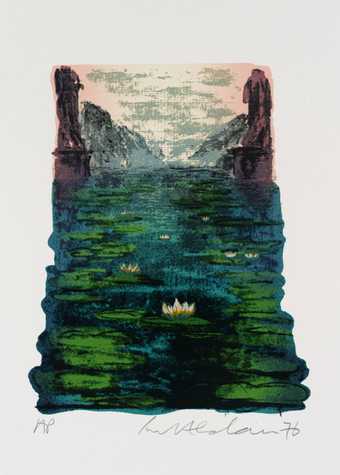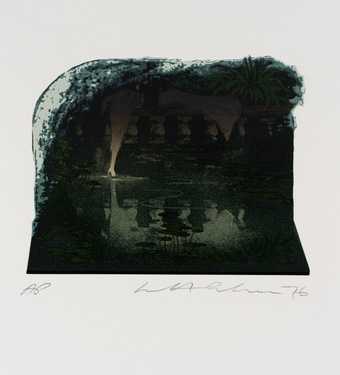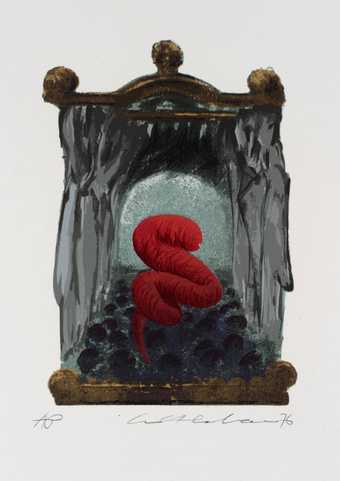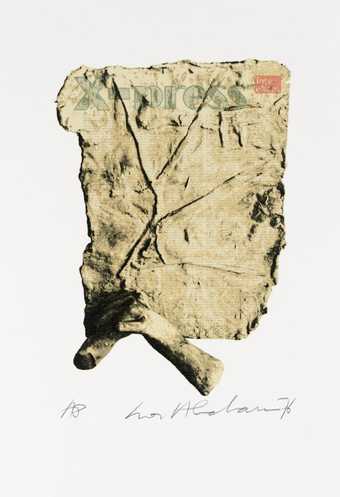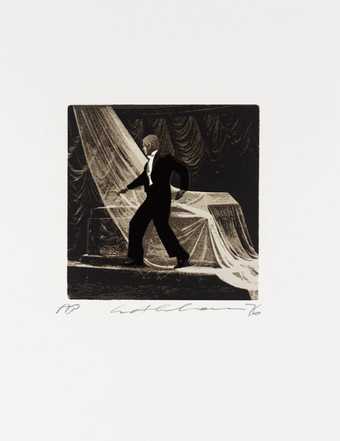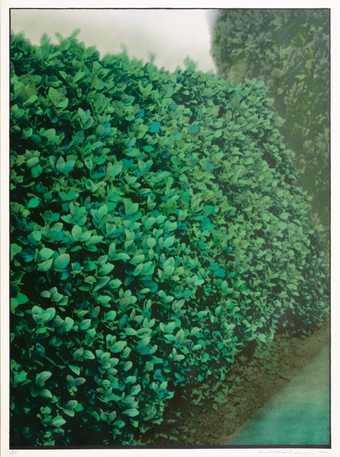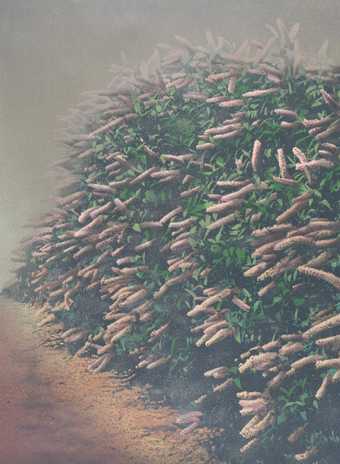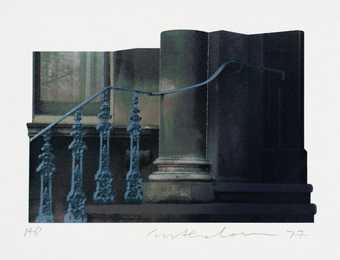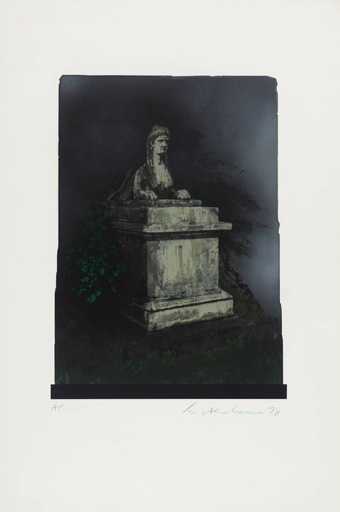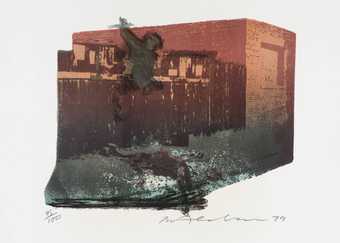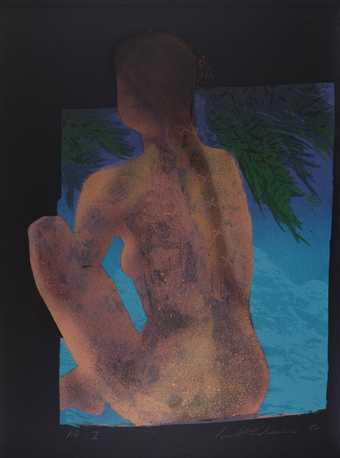
In Tate Britain
Prints and Drawings Room
View by appointment- Artist
- Ivor Abrahams 1935–2015
- Part of
- E.A. Poe: Tales and Poems
- Medium
- Screenprint on paper
- Dimensions
- Image: 227 × 163 mm
- Collection
- Tate
- Acquisition
- Presented by Evelyne Abrahams, the artist's wife 1986
- Reference
- P11153
Catalogue entry
Group of ninety-eight screenprints, lithographs and etchings, various sizes [P11099-P11196; incomplete]
Presented by Evelyne Abrahams, the artist's wife 1986
This group of prints was bequeathed to Evelyne Abrahams by the artist's parents, Harry and Rachel Abrahams, on the understanding that she would present it to the Tate Gallery on their behalf. It represents the greater part of the artist's printmaking to date. Other works by Abrahams in the collection are a sculpture entitled ‘Lady in a Niche’, 1973 (T03369), a work on paper entitled ‘Winter Sundial’, 1975 (T02330), and a small number of prints: ‘The Garden Suite’, 1970 (P04001-P04005), ‘Sundial I (Summer)’, 1975 (P07384) and ‘Untitled’ [from the artist's book Oxford Gardens: A Sketchbook], 1977 (P08150).
Abrahams is primarily a sculptor, and many of his prints relate to particular sculptures. In the period 1967–79 Abrahams focused on garden imagery, exploring the relationship between art, artifice and nature. Many of the images used in early prints were based on small, relatively poor quality photographs of gardens reproduced in gardening magazines, such as the weekly Amateur Gardening and Popular Gardening, or, less frequently, better quality illustrations found in the series of volumes on gardens published by Country Life in the 1920s. This use of second-hand source material gives much of his printed output a conceptual quality, and links his work to Pop art. Abrahams has presented a large amount of source material relating to his printmaking of this period, including magazine clippings, photographs and sketches and acetate stencils, to the Tate Gallery Archive (TGA 8315).
The critical and commercial success of ‘The Garden Suite’ (P04001-P040054), published in 1970, helped establish Abrahams' name internationally, and in the following decade he went on to produce a significant body of prints, making approximately one print a month. The dealer Bernard Jacobson published many of his portfolios, and the Mayor Gallery organised a series of touring shows of prints and sculptures. In this period Abrahams was based in London, working at a studio in Leonard Street, EC2, from 1969 to 1982, and at the A & A Foundry in Bow from 1982 to 1992, with a second studio at Butler's Wharf from 1974 to 1979.
In 1979 Abrahams abandoned the garden theme for which he had become well known and focused instead on water-based imagery, using bathers and nymphs which were inspired in part by the landscape, myths and folk customs associated with the South of France. Abrahams and his French wife bought a home in Pézenas, in the Languedoc, in 1973, where he used the cellar as a studio. In 1988 they bought a house in the small village, Castelnau de Guers, in the same region, and have lived there on a full-time basis since 1992.
Unless otherwise stated, all quotations by the artist in the following entries are taken from a taped interview with the compiler held on 18 August 1994. The entries have been approved by the artist.
[from] E.A. Poe: Tales and Poems 1976 [P11135-P11154]
Portfolio of twenty screenprints, some with embossing and/or varnish, various sizes, on wove Crisbrook paper 495 × 362 (19 1/2 × 14 1/4); printed by Bernard Culls at Advanced Graphics and published by Bernard Jacobson Ltd in an edition of 100 plus 10 sets of artist's proofs of which this is one
Each inscribed ‘Ivor Abrahams 76’ below image b.r. and ‘AP’ below image b.l. (except P 11135 which is inscribed ‘Ivor Abrahams 76’ below image b.r. and ‘A.P.’ below image b.l. and P 11143 which is inscribed ‘Ivor Abrahams 76’ below image b.r. and ‘AP.’ below image b.l.); each stamped with the printer's stamp ‘ADVANCED GRAPHICS LONDON’ in circular device b.r.
Lit: Norbert Lynton, ‘Ivor Abrahams/Edgar Allan Poe’, in Ivor Abrahams: Sculptures and Prints, exh. cat., Bernard Jacobson Gallery 1976, [pp.15–17], entire suite repr. pp.16–20 and on inside of back cover, no numbers (unspecified impressions). Also repr: Ivor Abrahams: Edgar Allan Poe, brochure, Bernard Jacobson Gallery 1976, entire suite, no numbers (unspecified impressions)
Abrahams was commissioned by Bernard Jacobson to illustrate a volume of selected tales and poems by the American author Edgar Allan Poe (1809–49). It took two years to complete the proofing stages of the twenty prints, which were first exhibited in 1976. It was the artist who suggested making the prints available as a portfolio. The portfolio proved popular, and the project of publishing a book (announced in the 1976 exhibition brochure as scheduled for the following year) lost impetus. The book was due to be published in an edition of 500, with four loose prints per volume.
Norbert Lynton wrote an extended essay on Abrahams' illustrations which was intended for publication in the book. Unfortunately, the manuscript cannot now be traced, and only part of the essay was included in the 1976 Bernard Jacobson Gallery catalogue. Lynton ([p.15]) wrote: ‘I suspect that Poe's popularity through text, illustrations and films is part of his attraction for Abrahams. Yet, unlike all the films and most of the illustrations, his images show little desire to profit from the more thrilling aspects of Poe laboured by Arthur Rackham and the film directors.’ He continued ([pp.16–17]):
Abrahams un-Hollywoods Poe but uses some of Hollywood's tricks to do so. His other means are astonishingly un-period, un-hagiographic, ahistorical - in short, devoid of nostalgia. He is a plastic artist, a sculptor whose primary means of expression are form and interval. His images show a marked response to the constructive artist in Poe and much less attachment to the incidents that others focused on.
In conversation with the compiler Abrahams said he had admired Poe's writings since a teenager. He also emphasised that illustrating the text had given him the opportunity to address figure-ground relationships, the underlying theme of all his subsequent work. For the portfolio he chose to illustrate those stories or poems he felt he ‘could put an image to’. Although some of the stories and poems are among Poe's most famous writings, others are quite obscure. Abrahams commented that he had some difficulty in finding a truly complete edition of Poe's writings. The edition he finally worked from was the three-volume Collected Works of Edgar Allan Poe, edited by Thomas Ollive Mabbott (Cambridge, Massachusetts, I, 1969, II–III, 1978).
In 1976 Abrahams began work on a film on Poe with two friends, the painter Chris Battye and Richard Roberts, a cameraman and editor. Some of the film, which was never completed but was titled ‘The Sphinx’, after a Poe tale, was shot at Coalbrookdale, Ironbridge and Kensal Green (TGA 8315). A still from the film was used as a basis for the last print in the portfolio, also titled ‘The Sphinx’.
P11153 Silence - A Fable 1976
Screenprint with embossing and varnish 227 × 163 (8 7/8 × 6 3/8)
This depicts an open-jawed hippopotamus, varnished and embossed, in a sea accented with orange light from the horizon. The animal's lower jaw extends beyond the bottom edge of the image. In front of the large rock on the left, which is varnished, a small male figure, with a raised arm, can be seen.
The image appears to relate directly to a passage in the story where a demon describes watching a sorrowful, weary man on a rock by the banks of ‘the dreary river Zaïre’ with its ‘yellow ghastly waters’ and legions of water-lilies:
the man listened to the sighs of the water-lilies, and to the murmur that came up from among them... And the man trembled in the solitude; - but the night waned and he sat upon the rock.
Then I went down into the recesses of the morass, and waded after in among the wilderness of the lilies, and called unto the hippopotami which dwelt among the fens in the recesses of the morass. And the hippopotami heared my call, and came, with the behemoth, unto the foot of the rock, and roared loudly and fearfully beneath the moon.
(Mabbott, ed., II, 1978, p.197)
In conversation the artist said the man shown in P11153 was a intended to be a self-portrait. The print was acquired with the erroneous title ‘Silence - A Parable’. The artist has confirmed that he wishes the print to be known by the title of the Poe tale.
Published in:
Tate Gallery: Illustrated Catalogue of Acquisitions 1986-88, London 1996
Explore
- emotions, concepts and ideas(16,416)
-
- emotions and human qualities(5,345)
-
- isolation(290)
- universal concepts(6,387)
-
- silence(57)
- actions: postures and motions(9,111)
-
- floating(36)
- man(10,453)
- self-portraits(888)
- River Congo(1)
- arts and entertainment(7,210)
-
- artist, sculptor(1,668)
You might like
-
Ivor Abrahams Garden Suite V
1970 -
Ivor Abrahams Hollyhocks
1972 -
Ivor Abrahams Alone
1976 -
Ivor Abrahams The Valley of Unrest
1976 -
Ivor Abrahams Lenore
1976 -
Ivor Abrahams The Conqueror Worm
1976 -
Ivor Abrahams The Masque of the Red Death
1976 -
Ivor Abrahams Xing a Paragrab
1976 -
Ivor Abrahams Ligeia
1976 -
Ivor Abrahams Hedges I
1977 -
Ivor Abrahams Hedges II
1977 -
Ivor Abrahams Oxford Gardens VII
1977 -
Ivor Abrahams The Sphinx
1978 -
Ivor Abrahams [no title]
1978 -
Ivor Abrahams Vahine II
1984

